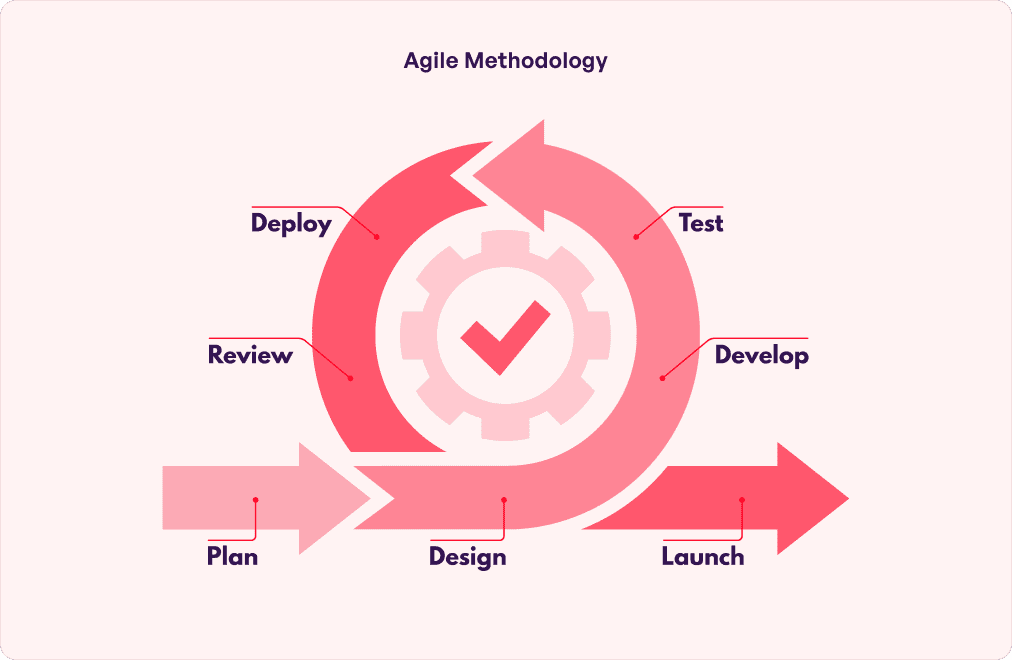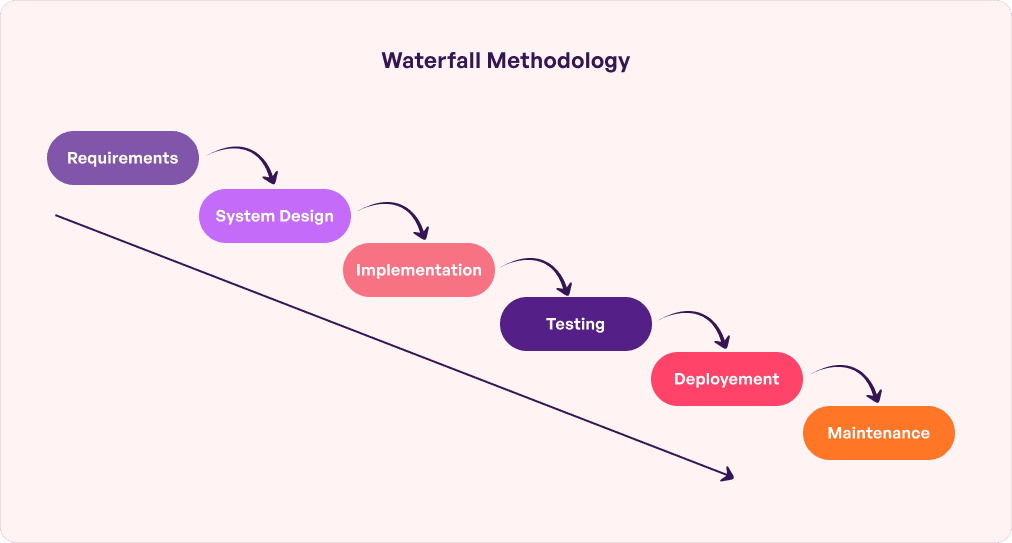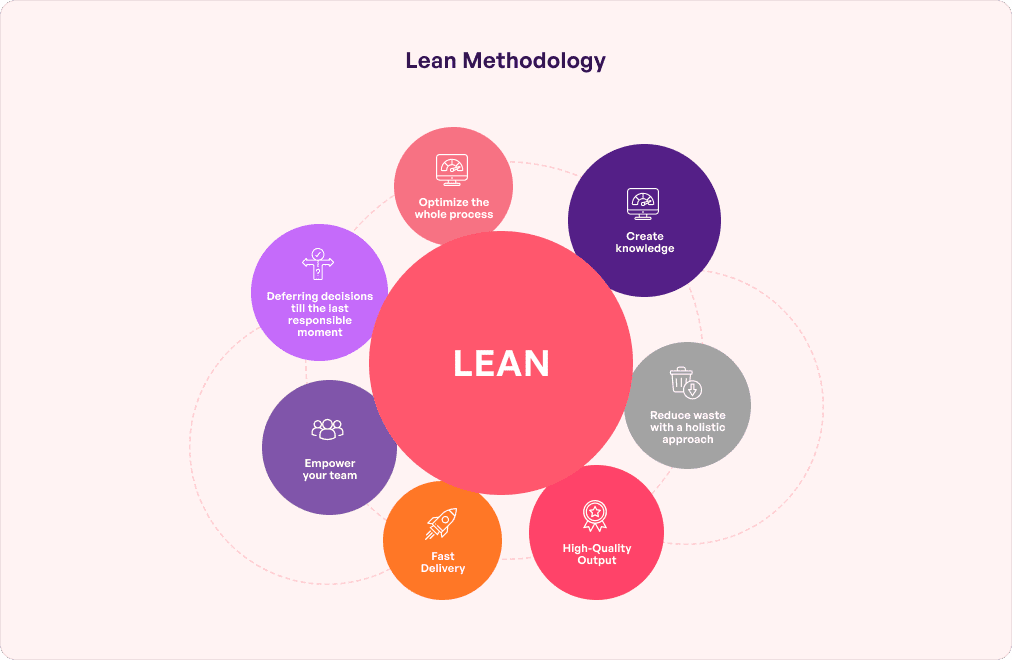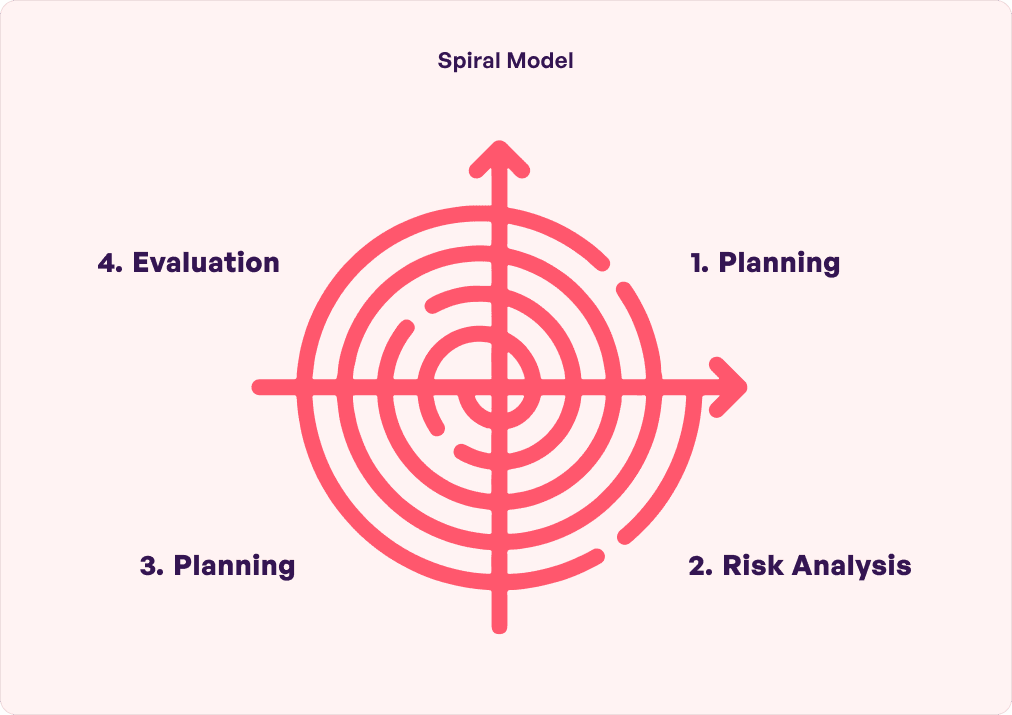Software Development Life Cycle is a well-structured process of building software. Did you know it was first introduced in the 1970s?! Well, software development spans not across decades but centuries! Over the years, the end-goal has remained the same: to ensure high-quality and error-free deliverables in the shortest possible time paired with gap analysis and reduced risks. SDLC methodologies are organized sequence of stages like:
- Planning
- Designing
- Implementation
- Testing
- Deployment
- Maintenance.
Wondering how all of this works? Well, software development methodology breaks down the tedious phases of software development, as mentioned above, to help programmers evaluate and modify each one. This ensures robust defect rectification thus boosting product quality. When customers have a positive experience on your app, they are likely to spend 140% more which ultimately adds to your revenue.
 The software product market has been growing significantly and is expected to reach $1605.89 billion by 2024. This is because traditional companies are migrating to the digital realm for increased brand recognition while start-ups are looking to uptick scalability. At this point, selecting the correct SDLC model becomes necessary. This article explains multiple SDLC methodologies and how to decide on the right one.
The software product market has been growing significantly and is expected to reach $1605.89 billion by 2024. This is because traditional companies are migrating to the digital realm for increased brand recognition while start-ups are looking to uptick scalability. At this point, selecting the correct SDLC model becomes necessary. This article explains multiple SDLC methodologies and how to decide on the right one.
Table of contents
The top SDLC methodologies: which one is the best?
Each of the below methods have a unique approach to develop sophisticated software. Let us understand which one is ideal for different organizations.
1. Agile methodology
If you are a startup, this software development methodology is the ideal choice for you. Its selective principles are also often a good fit for specific activities like software testing for traditional companies. The 17th State of Agile Report found that 71% of the survey respondents use Agile in their SDLC.
It has been designed with speed, flexibility, rapid prototyping, collaboration, and adaptability in mind – the keys to any startup success. Moreover, agile SDLC ensures that the end product is customizable to suit the changing needs. This is perfect since they are constantly updating, and evolving.
 Let’s understand how it works.
Let’s understand how it works.
In the Agile SDLC process, a big project is broken into smaller ‘sprints’ or time-boxed cycles that typically last for 2-4 weeks. Now, developers can prioritize any feature of software initially or at any given point rather than following a set bureaucratic chain. As a client, you may keep your requirements to the minimum and gradually add or alter them to refine the deliverables in the later stages. This ensures fast time-to-market and increases the possibility of overtaking competitors to move to the next shiny solution before they do. Agile development is broken down into 6 stages with improved speed and productivity and tools and roadmap.
- Concept
This is a detailed documentation of the project outline, vision, objectives, requirements, and results. The developers will flesh out the timeline and cost as well which helps you have an end-to-end understanding before you give a go-ahead to the team.
- Inception
The team starts working with the necessary tools and resources. This will include a rough draft creation with the project architecture and user interface. The software development risks are also identified and assessed. In short, it is an early stage of envisioning how the final product will look.
- Iteration
Here, you are encouraged to provide frequent feedback. It helps the development team to adopt and convey the same to the UX designers and ultimately align with your shifting requirements. The basic functionalities are developed at first and tweaks are made further into other cycles. Now, the product will be delivered in small cycles within 1-2 weeks.
- Testing
The quality assurance team conducts performance checks – which includes both manual and automated tests. The various types are unit testing, integration testing, acceptance testing, and system testing. The idea is to make sure the features comply with specific requirements along with making it dependable and error-free. When the product passes all of them, it is ready for the next stage, which is, release.
- Release
In this stage of the software development life cycle, a fully functional and efficient product with clean code is delivered. This is done after all the features have been tested and prepared to be deployed. Accepting testing is done in this stage of the software product development life cycle. After verification, the product is finally launched and made available to users.
- Review
The developers offer ongoing support and upkeep. This phase of the Agile SDLC model is also known as the maintenance phase. Here, you can request an improvement in features and address flaws. For example, bug fixing is done to improve product value. You can also ask to refresh the existing product with upgrades and new features. All of these make sure that the application runs effectively without hiccups.
- Retirement
This software development life cycle phase begins when the system has become incompatible with your organization. So, the team will perform data migration safely and shut it down without issues. The goal is to ensure a hassle-free exit from the organization’s portfolio. Alternative versions or products are typically made available at this stage.
Agile SDLC ensures that the end product is completely customizable to suit the changing needs. This is perfect for startups since they are constantly updating and evolving.
Know that this SDLC framework has a few cons as well, just like any other methodology. For instance, high-end flexibility would mean less predictability of the timeline required to complete a project successfully. Further, the project might get derailed at times due to improper planning. However, the many advantages of the Agile methodology outweigh the disadvantages.
2. DevOps methodology
This software development lifecycle model is a mix of both software development and operations like integration, testing, deployment, and monitoring. It enables reliable, quick, and continuous software delivery. So, it is no surprise that the global DevOps market size is predicted to grow to $88.62 billion by 2023. It ensures increased efficiency and output since there is less disconnected workflow and fewer knowledge gaps. No wonder Puppet’s State of DevOps shows that 80% of organizations today have implemented DevOps methodology.
 DevOps software development life cycle model is ideal for businesses that aim to develop apps to stand out in their respective industries. The CIO British multinational insurer Aviva says that all businesses require DevOps, it is not just mere hype that will fade away soon. This explains why Trainline, an online train ticket seller saw a 60% downtime reduction after using DevOps.
DevOps software development life cycle model is ideal for businesses that aim to develop apps to stand out in their respective industries. The CIO British multinational insurer Aviva says that all businesses require DevOps, it is not just mere hype that will fade away soon. This explains why Trainline, an online train ticket seller saw a 60% downtime reduction after using DevOps.
A few DevOp trends include increasing AI and ML into the software development life cycle phases. This will boost data analysis, bug identification, and security.
Let us now look at the different phases of DevOps:
- Planning
The roadmap of your project, goals, and requirements are discussed here to get a clear understanding of your expectations. SMART objectives are determined as well: Specific, Measurable, Achievable, Realistic, and Time-Bound which helps developers take one step ahead towards their goal. In short, this SDLC life cycle stage is instrumental in getting an idea of the purpose, outcome, and end goal.
- Development
This is the ‘how’ stage of this software development life cycle model. The development team will begin coding, following industry-best practices in accordance with the specifications. After which these codes are translated into executable files like Maven, Ant, and Gradle and pushed to the next stage.
- Building
Also known as the construction phase, the new code is integrated into the existing source code. The process includes a combination of unit and integration testing, packaging, and code review. Build automation tools like Travis CI, GitLab CI/CD, and Jenkins are used to automate the process. Jenkins, especially, is quite popular since it fetches the upgraded code and transforms it into an executable build.
- Testing
In simple terms, testing means reviewing the code for errors and bugs. It is tested for ‘corner case’ and ‘edge case.’ too. Further, unit testing, integration testing, acceptance testing, and system testing are also done. The QA team typically uses JUnit, TestNG, and Selenium which allow multiple code bases side by side.
This multi-faceted continuous testing ensures quick feedback, code changes, and software quality.
- Deployment
The software reaches this SDLC life cycle stage when all the tests have been passed satisfactorily. This stage mainly involves deploying build architects to target:
- Development
- Staging
- Production
Once a reliable automated testing is in place, continuous deployment (CD) is a must. This makes sure the code is deployed on all servers while removing the need for routine releases. Configuration management holds plenty of value during this phase. The process involves configuring and maintaining consistency in the functionalities of the app. A few tools that can be used are Chef, Ansible, and Puppet.
- Monitoring and Feedback
Product feedback, areas of improvement, and complications are outlined and documented. This helps improve the existing version and release a new one based on your feedback, if any. Altogether, this SDLC life cycle stage streamlines the development process.
- Operation
The product is now live for customers. This software development life cycle stage is the shortest and easiest to understand. At this stage, the operations team will manage server configuration and provisioning with tools like Chef. It speeds up the deployment process.
Despite the pros like high efficiency, better collaboration, and minimal risks, DevOps is not without its share of cons. For instance, DevOps can fail if you set unrealistic goals like quick fixes for developmental challenges. The best solution is to set reasonable goals for achieving it better.
 At Simublade, 90% of our developmental initiatives are a mix of Agile and DevOps to offer cutting-edge end products. We also strive to incorporate the best-in-class tech stack to make sure the approach is a great fit for your business. Visit our page to get an idea of how we implement these software development solutions.
At Simublade, 90% of our developmental initiatives are a mix of Agile and DevOps to offer cutting-edge end products. We also strive to incorporate the best-in-class tech stack to make sure the approach is a great fit for your business. Visit our page to get an idea of how we implement these software development solutions.
3. Iterative methodology
This process begins with the implementation of a simple and small set of software requirements. Modifications like a broader set of features are added gradually. In simple terms, a big program is broken down into smaller chunks. The phases include:
 This is one of the most suitable SDLC methodologies for startups, given that you can handle the repetition of the process. It especially works in cases where there is no complete information on requirements beforehand.
This is one of the most suitable SDLC methodologies for startups, given that you can handle the repetition of the process. It especially works in cases where there is no complete information on requirements beforehand.
4. Waterfall methodology
This is one of the SDLC methodologies particularly known to help a project flow smoothly which helps the software development team meet your deadlines. It follows a sequence of steps or a linear approach. A clear and precise structure ensures high stability. This methodology has a fixed budget and time plus is quite easy to understand which is apt for new entrepreneurs.
 However, there are two sides to the same coin! It might prove difficult for startups since the Waterfall methodology leaves almost no room for revisions. Even the smallest change can cause significant delays since the work that has been done till a point goes in vain. Further, there is little chance of you being included in the project to clarify your expectations.
However, there are two sides to the same coin! It might prove difficult for startups since the Waterfall methodology leaves almost no room for revisions. Even the smallest change can cause significant delays since the work that has been done till a point goes in vain. Further, there is little chance of you being included in the project to clarify your expectations.
5. Lean methodology
Lean software development solution is an Agile framework. It is lightweight and is highly focused on lowering the time and resources required, eliminating waste, and delivering exactly what the product needs. A bare-minimum version is released into the market and changes are made depending on customer feedback.
 This makes it helpful for startups or companies that do not wish to spend a fortune on resources for product development. You can simply go ahead, test the product in the market, and implement changes accordingly. This also creates a space to experiment with creativity for customer satisfaction.
This makes it helpful for startups or companies that do not wish to spend a fortune on resources for product development. You can simply go ahead, test the product in the market, and implement changes accordingly. This also creates a space to experiment with creativity for customer satisfaction.
Toyota had first initiated the Lean approach and multiple other manufacturing teams followed its footsteps. This is because they identified the top advantages like a streamlined approach, prioritizing essential functions, and optimizing workflow.
6. Spiral methodology
This is one of the most flexible SDLC methodologies and a combination of waterfall,prototype models. The Spiral model is ideal for entrepreneurs who are looking to start afresh or enhance their current projects.
 It has a fantastic risk-driven approach and is perfect for large and complicated projects. You can see how the product will work and feel which ultimately boosts your satisfaction.
It has a fantastic risk-driven approach and is perfect for large and complicated projects. You can see how the product will work and feel which ultimately boosts your satisfaction.
It includes 4 key stages:
- Planning
- Risk Analysis
- Product Development
- Next Phase Planning
However, continuous prototyping and risk analysis can be expensive and time-consuming. Further, certain stages might need extensive documentation and the number of Spiral SDLC life cycle stages might remain unknown. This ends up causing delays in your deadlines.
The future of SDLC – new practices
Software development is a diverse landscape yet we can expect to see more groundbreaking developments in the future. This includes Blockchain Technology, Artificial Intelligence, Augmented and Virtual Reality, Quantum Computing, Edge Computing, and Sustainability.
Further, other future predictions include serverless architecture, Big Data analysis, IoT, hybrid cloud, and Containerization Technology. These would be more prevalent in the future. Let us look into what we do as we conclude the article.
 At Simublade, we offer exactly these. We are a software development company with an expert team of engineers, designers, strategists, and researchers in Texas. We have designed digital products from scratch using the most complex technologies to offer creative solutions that increase ROI by 3X.
At Simublade, we offer exactly these. We are a software development company with an expert team of engineers, designers, strategists, and researchers in Texas. We have designed digital products from scratch using the most complex technologies to offer creative solutions that increase ROI by 3X.
Our professionals are constantly pushing boundaries, fostering a collaborative spirit, and prioritizing innovation. From Blockchain to AI, we tick off these future-readiness boxes to ensure error-free, smooth, and faster delivery cycles. Talk to us today to get started.
FAQs
Q. What Makes SDLC Indispensable in Software Development?
Ans. SDLC breaks down the entire development process into smaller components. The idea is to minimize risks while working precisely on each stage to make the necessary changes. Overall, it helps to ensure high-quality software.
Q. What factors should a development team consider when choosing an SDLC methodology for a new project?
Ans. Consider the following:
- Scope and complexity
- Timeline and budget
- Pain points and priorities
- Goals and boundaries.
Q. Which SDLC model is best suited for large projects?
Ans. The spiral model is the perfect solution for large projects. However, given the many advantages, Agile is quite suitable. In fact, as per the annual State of Agile Report, Agile methodology is the most loved one out of all.
Q. What are the methods to select an appropriate model?
Ans. Here’s how you can go about it:
- Learn about all the models, especially, Agile and DevOps
- Figure out your needs like project type, size, and geographical location
- Discuss your needs with professionals to get started.



